Not for the first time in recent years, Swiss Football League is discussing a change in the league format. There is no reason to abandon the successful 10+10 format. The expansion to 12+10 and considerations with regard to allowing Reserves to play in the Second Division of Swiss football would have a negative impact on all important aspects: quality of football, finances, safety and talent development.
1) Never Change a Winning Format
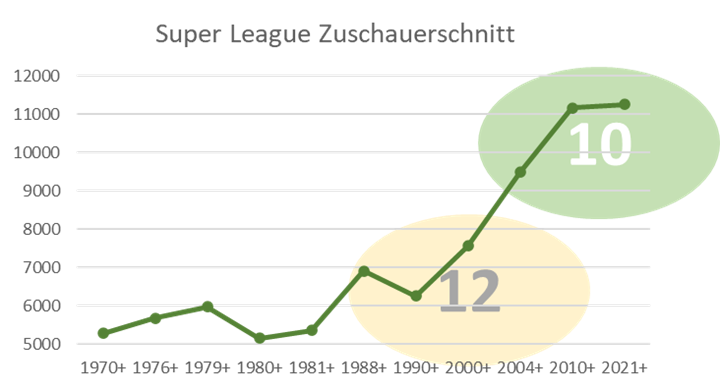
Since the introduction of 10+10, the Swiss national team has reached all finals with the exception of 2012. The playing time for club-trained players in the Super League has virtually exploded from 10% to currently 21.7% thanks to the 10-team league. Switzerland is among the top three in Europe in this category. The average number of spectators has increased from around 5,000 in the 16-team league, to 7,000 in the 12-team league, to 11,000 in the 10-team league. Measured against the number of inhabitants, this is a very high figure, even by international standards. Among other things, this increase in the number of spectators has enabled the Swiss professional clubs to massively expand their talent development with current annual budgets of the academies of up to 4 million Swiss francs per year.
With this format, Switzerland has also been able to offer its young talents an ideal platform for the leap into an international top league. Switzerland, small and not considered a “football nation”, has recently even been in first place of the Bundesliga’s ranking of foreign players. And despite a large drain of its own talent and limited financial resources, the Super League has also managed to stay in the top 15 of UEFA’s five-year rankings in club football most of the time. Even Challenge League clubs (Lausanne-Sport, FC Zurich, Vaduz) were competitive in Europe.
2) LOWER ATTENDANCE FIGURES ARE INEVITABLE
A league with an increased number of teams is always accompanied by a lower average number of spectators. In Austria, crowd numbers have decreased due to the enlargement of the league, even though the big Viennese clubs Rapid and Austria have opened new stadiums at the same time. Regardless of the format, teams have in average a higher share of games against less attractive opponents. And since spectator income is essential for Swiss clubs, both directly and indirectly (sponsoring, advertising money), this is a very important argument against league enlargement.
3) SIGNIFICANTLY LESS TV AND NATIONAL FEDERATION MONEY PER CLUB
With 12 instead of 10 participants, there will be less money left for each club from TV and association fees. The Super League clubs have to reckon with a reduction of 15-20% for these income items!
4) LESS TALENT DEVELOPMENT IN 12-TEAM LEAGUES THAN IN 10-TEAM LEAGUES
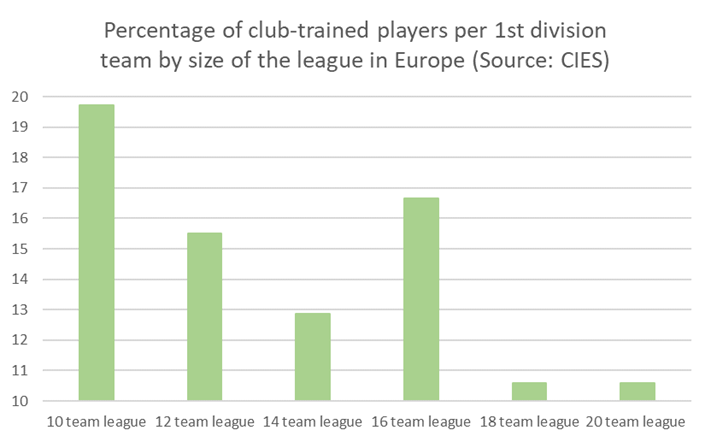
The Super League, with currently 21.7%, is number 3 in Europe in terms of the use of club-trained players according to CIES. The myth that a 10-team league leads to neglect of the club’s own young talent because of “greater pressure on the coaches” is demonstrably false. On the contrary: the statistics from all European 1st division leagues show that the use of players from the clubs’ own youth decreases with an increased size of the league! The difference between 10-team leagues (almost 20%) and 12-team leagues (slightly more than 15%) is particularly large. In Austria, for example, only 18.2% of the players stem from the club’s own youth, in Scotland only 10.8%.
If, as is often the case in a 10-team league, all teams are involved throughout the season either in the battle for the championship, the European Cup spots or against relegation, this supports young players in particular to develop their personalities. Main pillars of the national team in recent years, such as Yann Sommer, Steven Zuber or Tranquillo Barnetta, were shaped at a young age in the fight against relegation. If, on the other hand, a match is not really relevant for the outcome of the season, the intensity is considerably reduced and young players learn little more than in a test match. Only through resistance and pressure does a rough diamond emerge from basic elements. Talents who have what it takes mentally and football-wise for a top league are given confidence by their coaches in the Super League, even in difficult situations. Even at the age of 18, Ricardo Rodriguez and Granit Xhaka put in more consistent performances on the pitch than their much more experienced teammates.
5) INSUFFICIENT INFRASTRUCTURE AND LACK OF POTENTIAL FOR MORE THAN 20 TEAMS, AS WELL AS INCREASED SAFETY CONCERNS

Despite the temporary suspension of some decisive infrastructure criteria due to the difficult post-COVID situation, only 20 clubs were granted the Swiss Football League licence for the 22/23 season in the first round. If the licensing criteria had been applied consistently, the number would have been significantly lower, especially for the Super League. Nevertheless, an increase to a total of 22 clubs is proposed. It seems as if the reality of Swiss football is being ignored by the expansion proponents. A few years ago, a study showed that, given the size and structure of a country like Switzerland, 20 professional football teams is the upper limit of what is possible and affordable.
Austria (slightly larger than Switzerland) never got beyond 7,000 spectators on average and came to the conclusion that it was not in a position to maintain 20 professional clubs. Therefore, a step backwards was taken with the re-amateurisation of the 2nd division. Switzerland can run two professional leagues. However, only if they are not too big. Moreover, in order to ensure a reasonably meaningful competition for promotion to the highest league, at least half of the Challenge League clubs would have to have the (infrastructural) prerequisites for the Super League, i.e. a total of 12 + 5 = 17 clubs. But this is not the case. With a 12-team Super League, 17 clubs would also have to be able to receive visiting teams such as FCB, FCZ, YB or FCSG in terms of sector separation, installations and police presence.
6) DANGER OF RIGIDITY AND LACK OF VARIETY
If an increase to 12 teams actually frees certain clubs from relegation worries, this would lead to less dynamism and too little competitive pressure in the league. The league would also get more boring if, apart from FCB and YB, other clubs were to become quasi “non-relegateable” and therefore become de facto “inventory” of the top division.
7) DILUTION OF THE LEVEL OF COMPETITION
The quality of a league is determined by the quality of its players. An expanded First Division that is replenished “from below” with teams and players who would otherwise have played in the Second Division. With a professional squad of 25 men per team, these are the number 251 to 300 professionals in the country in a virtual ranking. These players basically remain professionals number 251 to 300 even through administrative promotion. They do not miraculously become better footballers. It is rather the case that the best 100 professionals of the league are less challenged by matches against these inferior teams and there is a danger that they will be affected by the lower pace. Ultimately, the average quality (technique, pace, intensity) of the league will be lower than before.
This applies to all competitions in every sport, nationally and internationally. The Champions League knockout stage with the best 16 teams has a higher level than the group stage with 32 teams. Even football laymen notice the difference. If the German Bundesliga were a 10-team league, it would have a Champions League-like level. From teams 11-18, the best 3-4 players would each move to the top 10 teams. It would be a football with much higher intensity, tempo and better technique than today.
So why doesn’t the Bundesliga implement this? Firstly, because in such a vast country, large regions with several million inhabitants would then no longer be represented. And secondly, because none of the other big leagues has dared to take this step so far – and Germany is therefore not at a competitive disadvantage in comparison with England, Spain or Italy because of the size of the league – on the contrary, they currently even have a small advantage. Moreover, in a big country like Germany, the difference in quality between the tenth-best and the eleventh-best team is not as big as in Switzerland.
8) FOOTBALL MUST NOT BECOME “CALCULABLE “!
Trying to make football “calculable” for club management is an anachronism. The most successful sport in the world thrives on its unpredictability: excitement, surprises, drama, crises and resurrection. It is a modern passion story. Calculable football is like a Metallica concert at ambient volume or a freestyle circus performer who doesn’t take any risks. Why should spectators go and watch something like that and pay for it? It is very good for Swiss football that 1.5 out of 10 teams are relegated. Admittedly, it’s nerve-wracking for the club managers, but that’s the way it should be! When there is a lot at stake, spectators flock to the stadium. The abysmal disappointment, the shambles, the radical turnaround: all these things captivate football fans. Relegation battles attract nearly as many and sometimes even just as many fans as championship deciders.
Professional football is part of the entertainment industry and this is not suitable for managers and employees who cannot cope with rapidly changing circumstances. Clubs like St. Gallen or FCZ have benefited from relegation to the Challenge League in recent years. They were able to reposition themselves, throw off heavy load, ignite a new closeness and enthusiasm among supporters and celebrate their return to the top. Nobody, on the other hand, celebrates a 9th place finish in a 12-team league. Wanting to bring “predictability” to football leads to the monotony of everyday life, bureaucracy, stagnation and a reduced ability to learn. All this is bad for international competitiveness and the national entertainment factor.
“As relegation is not possible, you don’t feel that thrill inside you. When you lose, you go home and think, okay, next week we’ll have another game.”
(Blerim Dzemaili about Major League Soccer)
9) CHALLENGE LEAGUE IS AT RISK
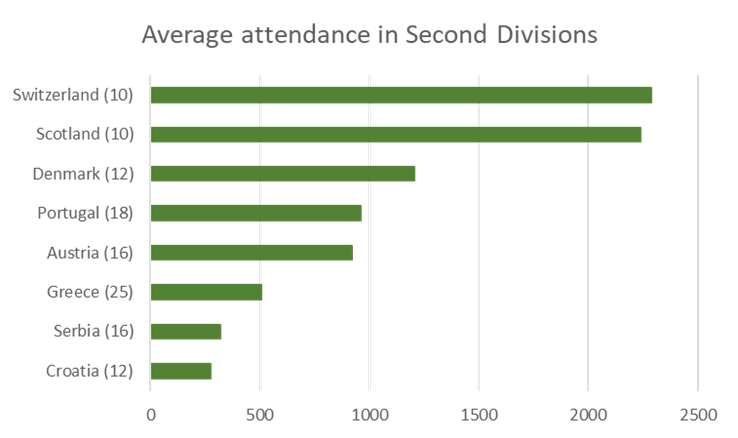
Expansion of the Super League to 12 teams would have a greater impact on the Challenge League than on the Super League itself. If the best two teams are taken away, not only will the quality of the Challenge League drop, but important sources of income (attractive opponents) will also be lost. In addition, the likelihood that clubs with a large fan base such as St. Gallen, FCZ or Lucerne would additionally revive the Challenge League from time to time decreases. The financial situation is tight in every country in the respective lowest professional league. It is no different in the Third League in Germany, for example, than in the Challenge League in Switzerland. Nevertheless, these leagues now function well.
The Challenge League actually boasts a high average number of spectators compared to Second Divisions in similar countries. However, an increase in Super League teams to 12 could lead to such a drop in revenue in the Challenge League that its survival as a second professional league would be called into question. And this could give a decisive boost to the advocates of a total dilution of the second-highest league (admitting reserve teams from the rich clubs).
10) FUNDING OF YOUTH ACADEMIES IN SEVERAL REGIONS AT RISK
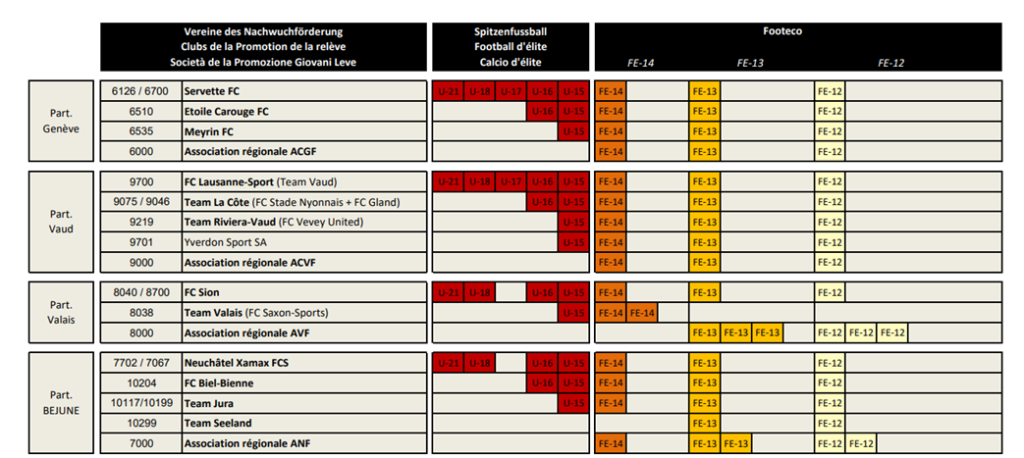
Over the past decades, the Swiss Football Association and the Swiss Football League have developed and constantly refined a sophisticated system to enable young talent to develop in the best possible way. The demands on the academies of the professional clubs in terms of professionalism have been continuously increased – which costs money. The professional clubs have only been able to raise this additional money thanks to the increase in spectator numbers and revenues in the two 10-team leagues over the last two decades.
The league expansion in the Super League (and possible expansions in the Challenge League) endangers in particular the important and large youth departments at locations such as Neuchâtel, Aarau, Thun or Winterthur. In addition, Wil, Kriens, Schaffhausen and Vaduz are also involved up to a certain level in the top junior football of the Swiss Football Association. The funds for this are generated by professional football. If they earn less money because of league expansion, Switzerland will lose important locations and spots for football talents.
11) HUNDREDS OF JOBS AT RISK
If the Challenge League can no longer be maintained as a professional league, hundreds of people will lose their jobs. The number of professional clubs will then be reduced from 20 to 12, 14 or 16. Hundreds of footballers, physiotherapists, professional and top junior coaches as well as administrative staff of the clubs will lose their jobs. In addition, many part-time and casual jobs will be eliminated.
12) RELEGATION TO CHALLENGE LEAGUE HARSHER
An “amputated” Challenge League with less revenues would mean relegation would be harsher shock to a Super League team than today. The footballing and financial differences between the leagues would be so significant that a relegation could really threaten a team’ s existence. It would be almost impossible to build a team with Super League potential in the Challenge League as such players would not want to play in a semi-professional or amateur league. A radical cut would have to be made and it would be almost impossible to get out of the resulting negative spiral of declining quality, revenues and spectator interest.
13) MISSING STEP IN TALENT DEVELOPMENT

For optimal development, a talent needs seamless progression in which he can take step by step, year after year. It is crucial that each stage is available and open to the talent. There are indeed giant talents who manage to make the leap directly from the U18s to a regular player in the Super League, but such cases are an extremely rare exception. Many talents need the intermediate step in a lower professional league such as the Challenge League.
The Swiss system successfully relies on the best talents learning to grow through adversity as early as possible. The best girls play with the boys for as long as possible and the most talented boys play with men as early as possible. At 16, a talent can already be mature enough for the “1. Liga”, at 17 he could then be ready for the Promotion League, at 18 for the Challenge League and at 19 for the Super League. A club that, like GC, Lucerne or St. Gallen at present, has its reserve team in the 1. Liga has the advantage over FCB, FCZ or Sion of being able to field in some cases a talent against men in competitive matches a year earlier.
For the Challenge League level, loan transfers are an option for talents from Super League clubs, as particularly FCZ and YB have recently practised very successfully. The same path is also possible through transfers, as in the case of Zeki Amdouni, who moved from Meyrin to Lausanne-Sport via Stade Lausanne-Ouchy (SLO). Before his commitment to SLO, the step into a Super League team would have been too big for Amdouni. At the same time, if the Challenge League were not a professional league, this step would have been too small for Amdouni! He would have had to switch to a league comparable to today’s Challenge League – and such options would then only exist abroad – for example, the Prva Liga (Slovenia’s First League). Many Swiss talents would not be willing or able take such a step and would be lost for football.
14) THE NATIONAL TEAM NEEDS A STRONG CHALLENGE LEAGUE AND SUPER LEAGUE
At U19, U20 and U21 level, Switzerland has the great advantage over many European countries of having a number of players who are regulars in the Challenge League and therefore play competitive matches against professionals week in, week out. This is in contrast to the large number of talented players on the opposing teams who, in this decisive phase of their development, still play mainly against other junior and reserve teams, where the result of the games are of secondary importance.
One third of today’s national team (Sommer, Akanji, Schär, Widmer, Zakaria, Freuler,…) took an important step in their development in the Challenge League. The high level of professionalism provided by the Second Swiss League was a decisive factor in being able to take one step after the other on the way to the Super League and later European top leagues. In the same way, it is important that the level of Super League is as high as possible which is better ensured in a 10-team league than in a 12-team league.
15) SUPER LEAGUE NEEDS A STRONG CHALLENGE LEAGUE
Since the start of the 10-team Super League in 2003, only three teams have been relegated in their first season (twice Vaduz, once Yverdon). A strong Challenge League brings variety to Swiss football because it prevents “gated communities” at the top level. The pressure from below increases the competitiveness and thus the quality of the Super League and its players. As an analogy on a higher level: Paris St-Germain, even with the best players and coaches in the world, repeatedly fails in the Champions League partly because they are less challenged in their home league compared to top Spanish or English teams.
16) CASE STUDY: AUSTRIA
The number of spectators in Austria has fallen sharply since the league expansion (Bundesliga: 12, 2. Liga: 16) and the admission of reserve teams to the 2. Liga. Although the big Viennese clubs Rapid and Austria were able to open their long-awaited new stadiums, the average number of spectators in the Bundesliga fell from around 7,000 to 6,000. In the 2nd Division, spectator numbers have even halved as a result of the expanson – from around 1,800 to 900. Both divisions now have only around half the average number of spectators as Switzerland does. This is despite the fact that Austria has a slightly larger population, a much more impressive football tradition and no competition from a second major popular sport like ice hockey in Switzerland.
The quality of the 2nd division in particular has decreased sharply due to the league expansion in the 18/19 season. As an example: Haris Tabakovic was the league’s fourth best and top scorer in the last two seasons, having previously not been a regular in either the Challenge League or in Hungary. Nevertheless, only four reserve teams still play in the 2nd division and two of them, Young Violets and Juniors Oberösterreich, are currently (May 2022) ranked on a relegation spot. Only Rapid II and Liefering (Salzburg) will probably be able to stay in the league. Liefering gravitates in a different dimension than all the other reserve teams. Thanks to one of the world’s best and most expensive training and scouting systems, the Salzburg branch manages to reach 2nd division level fielding an international all-U21 team. Juniors Oberösterreich, on the other hand, pays six players who are older than U21 – Rapid II even has eleven and the Young Violets twelve older players! So, the concept of U21 teams in the second-highest league actually only works for Salzburg. Loaning individual players to the 2nd division teams would make more sense for everyone else, both from a footballing and a financial point of view.
Even concerning the recent relatively successful phase in European Cup, the Austrian League primarily benefits from Salzburg. Coaches from the “Salzburg school” like Adi Hütter and Peter Zeidler have lifted Swiss clubs to a higher level, and of course there are many more such coaches in Austrian clubs. The same can be said about players. Switzerland benefits from Salzburg with Noah Okafor, Philipp Köhn and Bryan Okoh, Austria has of course much more players who trained and developed at this club and are afterwards able to celebrate victories in the European Cup with teams like LASK. The change of their league format, on the other hand, has harmed Austria on many levels.
17) RESERVE TEAMS IN THE SECOND DIVISION CLEARLY DO MORE HARM THAN GOOD
Allowing reserve teams of top clubs to play in the second highest league is sold as a measure to promote talent. But the opposite would be the case. For the following reasons:
- Such a league would have too few spectators and revenues to be able to operate it at the professional level. The level of the opponents of these U21 teams would therefore be more comparable to today’s upper half-of-table Promotion League than to today’s Challenge League teams. This is too low a level for potential future national team players like Yann Sommer, Manuel Akanji or Denis Zakaria at the age of 18, shortly before they are ready for the Super League. At this point, they need playing experience in a professional league with an intensity and quality just below Super League level.
- At the same time, even FCB, YB or FCZ do not have enough talent in an age group to form a competitive team at the second-highest level. FCZ, FCB, YB and Sion already cannot manage in today’s third-class Promotion League without experienced reinforcement players. In a second-tier division, the reserve teams might have to fill half the team with failed Super League professionals: expensive and unnecessary. On the other hand, a reserve team playing at a lower level (e.g. 1st division) can field 100% of its own youth players. In today’s Promotion League, it needs about two reinforcement players. From each academy age group, there are only 1-3 players who will manage to play in the upper two divisions in the future. Each of them needs an individual solution for his development. To move up a whole Reserve team to the 2nd division just for 1-3 players is nonsensical.
- Switzerland has a more federalist system than Austria, for example, with more clubs and regions involved in top youth training. 14 clubs have the full programme up to U21 (reserve team). However, the majority of these clubs would not have a reserve team in the Second Division and would not be able to loan players to the amateur clubs in the Second Division because they would not have professional training conditions. The second-highest league level would therefore be completely closed to talents from the majority of Swiss youth academies. Meaningful development steps season after season, as with Sommer, Freuler, Zakaria, Akanji and Co: would be severely hampered or even made impossible.
18) FEWER GAMES (AGAINST TOP CLUBS)
Depending on the format, an expansion of the league will result in fewer matches and certainly fewer games against attractive opponents for the average Super League club. This will lead to reduced revenues. Why impose further financial handicaps on top of the repayment of the COVID loans?
19) FEWER SEASON TICKETS SOLD
The introduction of play-offs could lead to a decline in season ticket sales in the medium term. The hard core fans will continue to see all competitive games of their own club for quite some time, but many sympathisers or casual spectators will focus more and more on the (few) play-off games in May.
20) LOSS OF NATIONAL SUPREMACY OF THE SUPER LEAGUE
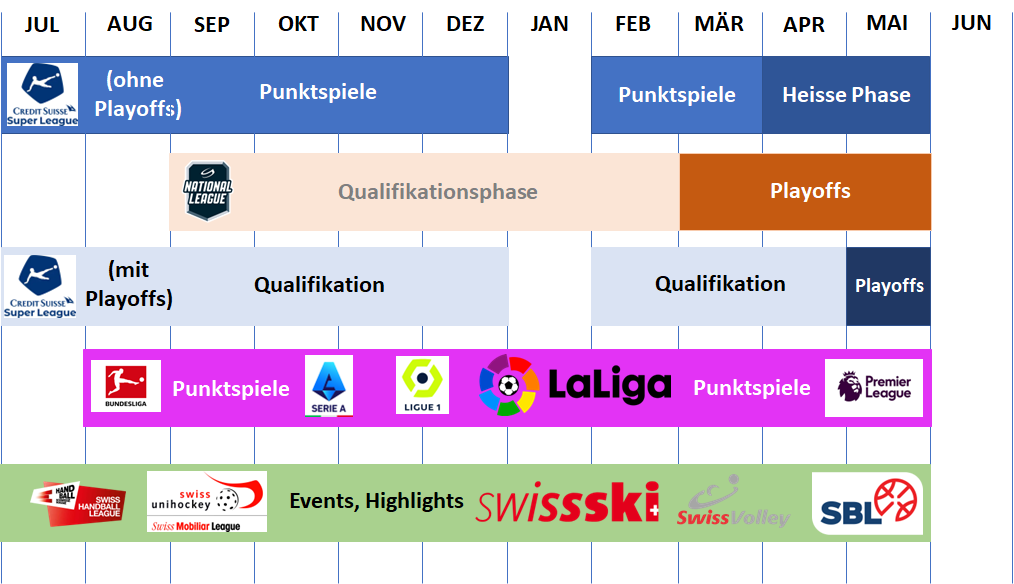
The Credit Suissse Super League holds a dominant position in Swiss sport today. Since (fully counting) points are at stake from the first matchday on, the Super League is number one in terms of TV and media presence in Swiss sport week after week from July to December and in February. From March onwards, the playoffs start in ice hockey and from March / April onwards, the hot final phase of the season begins in football. During this time, football and ice hockey are more or less equally represented in media.
With the introduction of playoffs, football carelessly gives up its pre-eminence for a large junk of the year! The vast majority of games will receive less importance and attention than they do today. To a certain extent, one can speak of an extension of the summer test games way into the following April. And there everything will be decided within a single month. It is the same month in which the ice hockey final (Best of Seven) continues to take place simultaneously. The capacity of the stadiums is probably not big enough to compensate the revenue losses suffered from July to April. Plus: already with today’s format, stadiums are pretty full for decisive games. It cannot be more than full.
It is highly doubtful that under these conditions the lower interest over many months could be compensated by an “unlimited play-off euphoria” for a small number of games in terms of revenue. Even more as most teams will only have a play-off for a spot in the European Cup. The Super League spectator numbers are already at the upper limit of what can be expected for a country as small as Switzerland today. In ice hockey, the play-off phase lasts a solid three months and all teams compete for the championship. Ice hockey has playoffs because North America is the ” state of the art ” in this sport. And the less well attended sports such as handball, basketball, floorball or volleyball have introduced special events and playoffs in order to enjoy the privilege of live TV broadcasts at least on a few days of the year. Football, on the other hand, does not need playoffs in terms of media attention! On the contrary, this could be a bullet in its own knee.
If there will be less interest in Super League from July to April due to the play-offs format, who would fill the gap? Certainly the top foreign leagues. Swiss people interested in football (especially the young) will focus even more on Germany, England, France or Italy where from the get-go every game is decisive. In addition, smaller Swiss sports, leagues and events will try to fill the vacuum left by football – with additional special events during this period.
21) QUALITY OF GAMES AND TALENT DEVELOPMENT DECLINES
Not only will media attention decline from July to April, but so will the quality of the games. Last weekend’s FC Zurich – Lausanne-Sport match is an example of what Super League football will look like in the majority of cases when there is little to nothing at stake in most of the games: slow, error-ridden, uninspired. This would not only be detrimental to the attractiveness of the league, but also to the development of Swiss talents. With the 10-team league, on the other hand, according to international studies, the Super League is among the best leagues in Europe in terms of intensity and runs. The games are attractive for the most part.
22) THE BEST SHOULD WIN
“Over the course of a whole season, luck and bad luck balance each other out”. This comforting insight no longer applies in a playoff system, especially in a best-of-3 or even best-of-2 format. Individual injuries, suspensions or VAR mistakes can ruin an entire season. Fairness is no longer guaranteed to the same extent as in a standard season with three points per game.